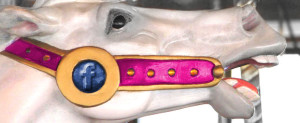Oh that age old question: What makes a perfect Facebook post?! Alright, so it’s not exactly an age-old question, but it’s certainly a good one. Making your Facebook page engaging is a top priority for social recruiting. That’s why we spend so much time on this blog writing about Facebook best practices, but words can only help so much. Which is why sometimes you simply need to consult an Infographic. This picture’s definitely worth a thousand words: Blueprint For The Perfect Facebook Post (an Infographic from Salesforce blog)
Read MoreFacebook Recruiting
Today is the most important holiday in my new home, Utrecht. In fact, it's the most important day in all of the Netherlands. It's Queen's Day, or Koninginnendag in Dutch. To an outsider, Queen's Day sounds like any other boring statutory holiday. Well, at least to this Canadian it did. But, here in Utrecht, it is anything but. The Dutch are completely, utterly, head-over-heels in love with their queen. The royal colour orange is featured in every window display. Dutch men wear orange pants, Dutch women wear orange dresses, and Dutch kids wear orange everything! Orange flags hang like canopies over the parks, there's a party on every block, a flea market on every street, and people everywhere sharing bright orange pastries. The Dutch know how to do a party. They also seem to really understand community. How to build it, how to keep it strong, and how to enjoy its many benefits. We've been focused a lot on community lately at Jobcast. It is in part because we believe social recruiting is all about engaging with one's online community, but also because we're working on some cool additions to our Facebook recruiting app! Our last two posts have sought to give our readers some practical tips to grow their social networks and Facebook communities. Today we're going to look at every recruiter and employer's most important type of community:
The Talent Community
A talent community is different from a talent pool, in that it's not just a spreadsheet filled with data on potential candidates. It is in fact, a type of network created by employers and recruiters for the purpose of improving their talent pipeline (here's a definition of a talent pipeline — sorry for all the jargon!). This network usually consists of potential hires, current employees, former employees, and past applicants. This group forms a community that can engage with each other to give referrals, stay up to date on job opportunities, and simply share information related to their profession, all via social networks. Cool eh? Facebook is the perfect place to foster a talent community. Its very nature encourages engagement, and you (hopefully) already have a strong employer brand presence on Facebook. Maybe (ideally!) you even have a branded Facebook Career Page with listed jobs. Now, before we get too excited, keep in mind that unless you are hiring chocolate-tasters, potential candidates are unlikely to spend a great deal of time engaging with your talent community. If you are not offering immediate employment, active candidates will probably be more inclined to spend their time looking at specific job postings. Passive candidates will, as always, be more inclined to spend their time on Facebook Liking pictures of kittens in fancy dress. Okay, so that's the cons out of the way! Let's look at why Facebook talent communities are awesome: Easy to join
People are busy. And aren't we all sick of filling out online forms? That's a huge part of why only 10% of people who visit career sites fill out applications. To join your Facebook talent community, all they have to do is Like your Career Page. 'Nuff said. Encourages a Good Fit
The key to a successful talent community is your current employees. Get them on board, engaging with your Facebook Page, and they will be a testament to your company culture. The way they interact, and what they post, gives potential hires insight into what your company culture is like. And vice-versa. Encourages Referrals
Your current employees are always an asset when it comes to referrals. Facebook talent communities make it even easier for them to recommend their peers to you. It also creates a place where you can actively ask for referrals and get real-time answers. There's also the potential to crowdsource referrals by finding connections between potential candidates and current employers or peers. You Can Snoop
(a little, don't get creepy!) Unlike with spreadsheets, you can engage with potential hires who are part of your talent community. You can ask them questions, either as a group or selectively, to get to know what kind of talent is out there. Try asking candidates what they think constitutes a positive work environment, or what they look for in an employer. That's a whole lot of pros! Oh, and not to mention that positive interactions on your Facebook Page help to strengthen your employer brand. If you still need convincing about the awesomeness of talent communities, check out this article by Lou Adler. I'd stay around and try to convince you more, but I have a queen to celebrate, and my face won't paint itself orange.
Read MoreLet’s talk about community.
No, not the show. Although that would be a lot of fun.
Instead, we’re going to talk about your Facebook community. It will be just as engaging, I promise. Well… maybe not as engaging as that infamous chicken finger episode, but I’ll try my best!
Last week we learned about online tribes. We learned what they are, how they work, and what they can teach us about running our own online communities.
This week we’re going to focus more specifically on Facebook communities.
Your employer brand and Facebook recruiting efforts are dependent on this thing called reach. In order for candidates to apply for your jobs, your job posts need to reach those candidates. Your employer brand grows when it reaches a greater number of users than it has in the past. The more active your Facebook community, the better your reach. It’s your online community that shares your posts, links back to your content and refers job-seeking friends to your Facebook Career Page. As such, you should love your community as much, if not more, than hilarious sitcoms and chicken fingers.
You should also do everything in your power to make that community as active as possible. Sure, you could bribe them with hot chicken fingers, but implementing the following tips into your Facebook strategy will be far less messy:
Know what you’re working with!
By determining what stage your Facebook community is at, you can come up with a better strategy for growing it. Use this template to figure out if your community is in the On-Boarding, Established, Mature, or Mitosis stage. It’ll help you decide how to interact with your community members and what types of content to post.
The On-Boarding stage is the earliest stage of your community’s development, and it requires the most hands-on managing. You’ll need to court new members and set the tone for future interactions. This TNJ article has some great advice for this stage of online community building.
If you’ve been working on your online community for awhile, it’s probably moved on to either the Established or Mature phase. Now, you can be a little less hands-on, as you’ll want to let your community begin to dictate the kind of content you post. Pay close attention to consistency. This article covers 10 ways to accomplish this.
The Mitosis phase is when your community gets so big, that it is no longer cohesive, and has to split into smaller factions. This is something most of us will never have to deal with, unless we work for Apple or Coca Cola, in which case, refer back to this article for some advice.
But, no matter what stage you’re at, you’ll want to …
Post great content
Your content should be helpful, varied, entertaining, and in line with your employer brand at all times. Obviously that’s easier said than done. Here’s some tips:
1. Divide your posts into categories. For example, your strategy could be to make 25% of your posts into links related specifically to your field. 25% could be witty observations (this is where Seth Godin’s blog comes in super handy) or questions posed to your Facebook fans. 25% interesting non-business related content (blogs like Lifehacker are great for this type of post). And 25% self-promotion.
2. Only post content you’ve vetted. If you haven’t read, watched or listened to it — don’t post it!
3. Post content that you would want to click on. Think about what shows up on your own personal news feed, what you like about it, and what words make you click through to a shared link. What would you share with your own colleagues and friends? Let this inform your own posts.
K.I.S.S. it
Always aim for the minimum. I know it sounds a little weird, but posting non-stop is kind of annoying. Having a presence on every single social network tends to water down your efforts, and responding to every comment someone makes on your Page with multi-paragraph answers is exhausting.
So, aim to do the minimum, but do it really really well. Post solid content consistently, but not constantly. Use Facebook as your main hub and select only a couple of other networks to use, instead of trying to spread yourself thinly over every social platform out there. Keep your interactions short, friendly, and to the point.
Engage and listen, but not too much
Always respond to your community members’ questions, ask them for input, and re-post interesting comments that they leave on your Timeline. People love to feel heard and you can learn a lot about how to grow your Facebook employer brand by listening to what your current community has to say.
But, (there’s always a but!) don’t listen too much. There will always be differing opinions, overly critical comments, and people with terrible ideas. For some reason, there’s even more people like this on the internet than in the real world. Don’t worry about pleasing everyone, just pay attention, engage and always stay true to your brand. You’ll do fine.
And the final and most important bit of advice is…
Be a human
No one wants to interact with a machine. That’s why thousands of iPhones are smashed every year due to Siri’s inability to understand me as an individual… Moving on… Don’t make your Facebook Fans karate-chop their laptops. It’ll really hurt your recruiting efforts (and their hand), and they will no longer be able to email you their resumes.
Be yourself, not a machine. Respond to people in a conversational tone. Own up to mistakes or gaps in your knowledge. Avoid jargon. Make bad jokes, or even better, make good jokes.
In other words, do as I say, not as I do!
Happy Facebook recruiting.
Read MoreSo, what do you think of when I say the word 'tribe'? Personally, my mind goes to a very dark place. First to hasty tattoos, then to Survivor, then to cast members of Survivor, covered in tribal tattoos, trying desperately to get more screen-time — by exposing their tattoos. A very dark place indeed. Hopefully you are far more mature than I am, and your first thoughts were, "Oh, tribes! Like communities, right?" Right! More specifically, we're going to discuss tribes in regards to online communities. Waaaay back in March, a bunch of research came out about the emergence of "Twitter Tribes". Basically, they're tightly-knit communities, forming on the social network, who shared specific interests and language. Language being the main identifier because, well, it's Twitter, not Instagram. But, why should we care about online tribes?
Other than the obvious reasons, like finding others who shared our obsession with Justin Bieber, we should care about tribes because of what they can teach us about creating, growing, and managing our own online communities. Brand visibility on social networks like Facebook is dictated by the ability to engage one's online community. When we talk about increasing Page Likes, gaining Twitter followers, and making job posts go viral, we are talking about online communities. That's where the Likes, Follows and Shares are coming from. Tribes are communities on steroids! Okay, not really. They are actually smaller than regular communities and would be more likely to spend time on bodybuilding.com forums, than actually pumping iron. Yet, they are very socially active communities. Tribes share, Like, and retweet stuff like crazy, which is what you want people to do with your content, and more specifically, with your job posts. So what can we learn from tribes? Words Matter
Online tribes use specific language. Sometimes it is very silly, like 'chillin', and sometimes it's not even recognizable as language, like '<33' (see Beiber Twitter Tribes for more examples). But no matter the specifics, what's important is that the language is shared, and that it is consistent. The takeaway: Use specific, consistent language when posting content and interacting with your online community. Choose words that represent your employer brand and fit with your company culture. This will encourage your online community to do the same, ensuring consistency, and helping define your online brand. Don't Have an Identity Crisis
Part of what makes using specific language so important to online tribes is that it acts as an identifier. Identifying as part of a group is important to people at a very base level. It's why we seek out community to begin with. Tribes use language, repeated themes, and naming to craft strong group identity. The takeaway: Create an identity for your online community. Name your community. For example: Bronies. These are adult male fans of the animated series My Little Pony. They are an extremely active online community, so instead of judging, we should learn from them. And then judge. Identification via naming is also important for content and events. Use the language you've created to help determine what to name your community events and use consistent naming for types of content. We've named our Wednesday blog posts "Link Love", so they are instantly recognizable to our community. Get Cultured
Tribes have their very own culture. The way tribe members interact with each other and conduct themselves is dictated by that culture. Shared values, behaviors and interests, as well as language, make up a tribe's cultural identity. And, as mentioned above, it is that identity that binds a tribe together, thus distinguishing them from regular online communities. The takeaway: Understand what your online community's culture is and let that understanding help shape your content and interactions. By keeping tabs on how your community members interact, what they share, and what they Like, you can determine their values and interests. Which allows you to tailor your own content to stay in sync with your community's culture. Encourage and celebrate that culture with your content, your comments, and even the occasional reward (like a promotion or contest). Tribes form naturally amongst humans. You really can't force your Fans and Followers to become a tribe, but you can interact with them in ways that promote more tribe-like behaviors. Just remember, language, identity, and culture. And Bronies, remember to Google Bronies.
Read MoreLast week we laid out the major ways in which Facebook's News Feed is going to change in the upcoming year. Today we're going to examine what those changes mean for employers and brands in general and how Facebook recruiting, branding and marketing will need to adapt in order to stay effective. I'll try not to get too heavy on you, but these changes are serious for anyone using Facebook for business. Of particular importance will be a major new emphasis on image-based stories and an increase in a user's control over what they see in their feed. Currently users have a rather limited ability to curate the content they view in their News Feed. They can hide specific posts, but not much more. With Facebook's recently announced updates, users will be able to filter content much more selectively. They will have the option to view updates from specific groups, such as "Friends" or "Close Friends". Users will also be able to view content from their "Following" feed (brands whose Pages they have Liked), but some marketers are worried that users won't choose this option.
Facebook has pitched these changes as a way to please users and that makes sense. The updates are in response to concerns that many users are finding their News Feed increasing cluttered. They complain that they are missing personalized content, such as a friend's important status update, due to this clutter. But I would also suggest that another reason for the updates to Facebook's News Feed is that it will make investing in Sponsored Stories, and paying for Facebook ads, a necessary step in increasing brand reach. The other major change is the increased focus on image-based posts. With over 50% of the updated News Feed devoted to image-based content, brands would be wise to shift away from using text updates. Brands will also have to curtail how much text is embedded in images that are used for marketing (no more than 20% is allowed). What this means for you:
Investing in Sponsored Stories and Facebook Ads will no longer be optional. Yes, I know, not having options isn't fun. But really, even without these changes, I've always advocated investing in both of these tools. It's inexpensive and a great way to learn more about your customer base.Silver Lining: Sponsored Stories and Facebook Ads will have a much larger visual presence, making them more impactful and engaging. Considering how easily users can tune out the small-scale content appearing on the right-hand side of their screens, having the News Feed center-stage is a pretty great thing.
Creating or purchasing eye-catching images will be a must. Again, this is something brands should already be doing. It is a bit of an investment, but social media is becoming more and more image-based and brands need to adapt, News Feed updates or not! Silver lining: It's a kick in the pants to make you take your branding's visual appeal more seriously! The updated images you use for Facebook campaigns can also be used to spruce up your company site.
Having varied media content is more important than ever, which is yet another argument for using video to boost employer brand! Sharing links that are accompanied by images will also be more important, so choose content to share from sites that include images with their posts. Silver lining: You have another awesome excuse to make an employer video! And hopefully blogs and online newspapers will make a greater point of including large, beautiful images with their articles.
All in all, the updates to Facebook's News Feed are definitely going to affect how employers and brands reach Facebook users. Hopefully, the overall effect will be only a slight cost increase in exchange for greater impact and visibility.
Sign up here to check out what Facebook will look like when all is said and done. We'd love to know your thoughts, advice and concerns in the comments! Happy Monday.
Read MoreMarch Madness is upon us! Unfortunately for me, no one here cares. Basketball is not that big in Holland, which is shocking, considering how ridiculously tall the Dutch are. Back home in Canada, this is an exciting time for my family. My parents are searching Google for tips on filling out their bracket choices, hitting up Costco for snacks, and mostly likely sporting Duke University hats. Ahhhh home.
But, luckily for me, I have another kind of madness to keep me entertained. Facebook Madness 2013!
The release of Facebook Graph Search kicked things off early in the year. It’s been exciting employers and recruiters everywhere with Facebook Graph Search’s promise of a much more selective way to search for talent and greater access to passive candidates. Also, over the past few months, Facebook timeline has been shifting and changing. Okay, so that hasn’t been super exciting — hiding maps under a “More” tab isn’t exactly madness… but I digress!
Now Zuckerburg has revealed FB’s plans for a completely re-vamped Facebook News Feed. Madness!
Whenever Facebook rolls out new changes, we get a little freaked out. Which is pretty frustrating considering FB shakes up their UI as often as Dennis Rodman dies his hair (yes, all of my basketball knowledge comes from the movie Space Jam). And, as with Rodman’s ever-changing coif, those changes can be awesome, but they can also be just plain scary for Facebook recruiting and branding. Before we go into the pros and cons of the News Feed’s new look, let’s go over just what those changes are going to be.
The five main changes :
1. Mobile – We all know that compatibility with mobile is no longer optional. More and more of Facebook’s active users are accessing the network through smart phones and tablets and Facebook is finally starting to make mobile a priority. Yay! The updates to News Feed put “mobile-first”, taking user interface cues from Facebook apps and emphasizing consistency between mobile and desktop interface.
2. Bigger Images – Another mobile-inspired change is the shift towards making images the main focus. Photos will dominate the latest version of Facebook News Feed, as they are now much larger and make up 50% of News Feed Stories. This is most likely inspired by the rising popularity of image-driven apps like Instagram, Pinterest and even Google+.
3. Less Text – More emphasis on images means less emphasis on text, which means text updates will become much less effective, if not obsolete. Facebook is also getting much more strict with it’s 20% text in images rule. This means a severe limit to “call to actions” and an end to “price and purchase info” embedded in images. It is another attempt by Facebook to have a cleaner, more elegant overall look and feel.
4. Multiple Feeds – Users will now have the option to choose certain “sub-feeds” that they would like to view more often. For example, users can choose to view more posts by “close Friends” than other friends (Google+ circles anyone?!). This will reduce clutter and make it easier for users to keep up to date with the content that matters most to them. These changes address increasing complaints by Facebook users that they are missing interesting updates due to an over-saturation with irrelevant content.
5. Chronology – Another way in which the changes to News Feed aim to quell user complaints is by displaying more content chronologically, with less reliance on edge-rank algorithm (a fancy term for Facebook guessing at what you want to see!)
Obviously these changes will make a huge impact on how employers will use Facebook to recruit and promote their brands. But the degree to which your strategy will have to change depends on what your current strategy is. If you are already running ad and sponsored story campaigns, and focusing on quality images, then big kudos! If not, then these changes may be a hassle, but they’re also a reason to revamp and improve how you use Facebook. This is always a good idea if you want to stay ahead of the competition.
Next week we’ll go over some pros and cons of the revamped Facebook News Feed, how to tweak your Facebook recruiting to make it work for you, and why Steve Nash is awesome and you should Like him on Facebook. Wait… he’s not in Spacejam! Disney really should release a new edition with him CG’d in.
Enjoy March Madness!
Read MoreIn last week’s blog we talked about taking the plunge into social media — not waiting for permission — just doing it. I asked our CEO and fearless leader, Ryan St Germaine, what he thought about the subject and in true Ryan-style, instead of bragging about himself, he expounded on our clients and best practices of social recruiters:
“From speaking with clients I’ve noticed that people get overwhelmed by social media and see it as this big, daunting task that requires a masters degree to understand. It’s not. All of the best social recruiters got started by putting one foot in front of the other and just going for it. They didn’t ask for permission or write a 40 page report. They created a social media account and started having conversations with their target audience. They engaged their audience by being of service and providing value. You can start right now if you want to with just one comment, message or post. The only thing stopping you from building your talent community… is you.”
I thought I would follow his lead and bring you some cool examples of people and companies who have done an awesome job of getting social with their recruiting, despite not having a masters in social (as if that even exists!?!)
I’ll start with someone who Ryan references often: Bill Boorman. Bill is a great example, in part because he has been doing social recruiting since before social recruiting was a thing, but mostly because he’s one of the most respected authorities on the subject. An early adopter of Twitter recruiting, he was the first person in the UK to register a business with an @ symbol in its name, and his trailblazing attitude towards recruiting didn’t stop there.
Bill started out as a traditional recruiter, but when faced with a lack of clients due to a recession, he decided to differentiate himself by going social with his recruiting. When he made this decision, the field of social recruiting was still in its infancy. He had no flashy social strategy infographics to follow, nor any of the impressive statistics showing the importance of social for recruiting that we now have, but he took the plunge anyway. This daring decision jump-started an illustrious career as a social recruiter, advisor, and public speaker.
Bill’s story is an awesome one, but wait, the awesome continues. An example I’ve used before, and will probably use again, is Stacy Donovan Zapar.
This is one connected woman — the most connected woman on LinkedIn to be exact. Stacy started her social journey with a focus on LinkedIn. She used the platform to become an early adopter of social recruiting, and then leveraged what she had learned to transform her own career. There was so much demand for her advice on social recruiting, that she began a blog which quickly became successful. This snowballed into a career as a public speaker at recruiting events, and now she has even launched her own social recruiting training business, Tenfold Social Training. Cool!
Our final example of social recruiting ingenuity is Jessica Lee and her work with Hotel Marriott.
Jessica Lee has taken Facebook recruiting to the next level with Hotel Marriott, but even before this campaign, both she and the Marriott brand were early adopters of social. Bill Marriott has been blogging since 2007, and the brand has been very active on Twitter and Facebook for almost as long, but they didn’t stop at conventional social recruiting. Hotel Marriott’s clever use of gamification for Facebook recruiting, with their My Marriott Hotel, has won them multiple awards and tons of press.
Jessica Lee has been using Facebook, Twitter and blogging to further her career in social recruiting since 2008 and is now considered one of HRExaminers top 100 influencers. In 2012, Lee signed on as Marriott’s Director of Digital Talent Strategy and has taken the company to new heights with innovative social recruiting projects like their recent Best Foot Forward campaign. Hotel Marriott and Jessica Lee have shown just how beneficial taking a chance on social can be.
All three of these examples took a risk on social recruiting back when it was still new and unproven. Today, Facebook is at over a billion users, LinkedIn is one of the first places recruiters go to find talent, and Tweeting for jobs is common practice. In the current social media focused landscape, as Ryan so elegantly put it, “The only thing stopping you from building your talent community… is you.”
Now, just so we don’t leave things on a cheesy note, I’m going to give you a teaser for next week’s article.
We’ll be sharing some firsthand advice from Reg Hamilton, a specialist in Interactive Media with over 18 years of tech experience. Reg represents Phoenix Group on the Board of Saskatchewan Interactive Media Association, serves on the Interactive Advertising Bureau of Canada’s Mobile and Social Media Council, and has one of the most viewed LinkedIn profiles of 2012.
In our interview, Reg shares some amazing tips for better social recruiting and explains how Phoenix Group has run extremely successful social media campaigns.
Stay tuned!
Read MoreThe internet is blowing up with articles about Facebook Graph Search. Such as : Facebook Graph Search is going to revolutionize social recruiting, Facebook Graph Search is bad news for LinkedIn, Facebook Graph Search is not that big a deal (yet), or, actually it is a huge deal but has a terrible name soon to be replaced by simply “Facebook Search”. Phewf. And it’s still just in Beta phase.
Honestly, as of right now, there’s really not much actual Graph Search to speak of and there won’t be for a quite while. That’s not to say we shouldn’t pay attention, stay informed, and tinker with the prospect. But it certainly doesn’t mean adjusting recruitment strategies or creating new job titles (though “Facebook Graph Master” would be an epic addition to any business card!).
So, what does it mean?
It means, let’s focus on the tools that do exist. Tools like Facebook Ads, Sponsored Stories, Career Pages, Video, and Page Branding.
Facebook has over a billion users now — it also dominates every other social network out there when it comes to the amount of time users invest in it — so, whether you are seeking love, a kickball team to join, or kick-ass candidates, it’s the logical place to look! (apparently Graph Search is going to be as big a competitor for dating sites as it will be for LinkedIn!) And those candidates are more reachable than ever with Facebook Ads and Sponsored Stories.
Facebook Ads.
Facebook Ads are important because they are easily-targeted to a specific demographic, and can reach candidates who are not connected to your Page. They increase your Page’s visibility and Likes, and grow your online community.
Here’s a simple tutorial about how to use Facebook Ads for recruiting.
Sponsored Stories
Now that your Ads are kicking butt and taking names (by names, I mean Likes) you can add some Sponsored Story action to your recruiting strategy. Increasing Page Likes is important in and of itself, but has the added bonus of making Sponsored Stories even more effective.
Facebook Sponsored Stories only reach users who are connected to you by having a Facebook friend who Likes your page or by Liking your Page themselves. This means a slightly smaller reach, but it’s worth it, because Sponsored Stories increase “Social Proof” by showing potential talent that their peers are into you. And as much as humans are loathe to admit it, we’re waaaay more likely to Like a Page if our friends do too. True Fact!
This is one of the reasons that Sponsored Stories have an extremely high CTR (click-through-rate). Another reason for their high CTR is that they show up directly in a user’s News Feed and have excellent visibility with mobile. We all know how crazy important mobile is. You can also choose to sponsor a story that shows potential candidates just how much their peers dig you — by promoting positive comments. For example, we got this lovely comment from one of our awesome users:
I have been using a lot of tools for online/social recruiting, Jobcast is by far the BEST. Thanks guys for this great tool! Looking forward to the upcoming features!
Not only did it make our hearts sing, it also made for a perfect Sponsored Story. Thanks Ruben! If you don’t have comments like this to promote, you can also sponsor Likes, but I highly recommend encouraging current employees to leave positive comments about their experience working for your company and promoting these. Current employees can be an amazing asset for improving your Facebook employer brand.
When potential hires click on your ads and stories, they will be directed to a landing page of your choosing. Please, please, please make it a Facebook Page, as we all know how much users dislike being directed off-site! It takes them outside of their comfort zone (Facebook) and makes them confused and grumpy – no bueno!
You want your candidates to click through to a Page that showcases your employer brand and company culture. Having a custom banner, integrating company colors, posting cool articles related to your field, and lots of staff pics (preferably ones that include foosball and cake!) are the best ways to make your Career Page appealing. Oh, and video!
Recruitment Video
If a picture is worth a thousand words, then a video is worth a billion.*
Embedding a recruitment video directly onto your Career Page is a must. You don’t need to spend a ton of money or use a lot of gimmicks to create a lovely, hilarious and inspiring recruitment video. So long as it expresses your company culture, values, and awesomeness with gusto, it will woo potential hires. This fantastic article has some great advice on how to make a great recruitment video on the cheap. I also recommend watching this recruitment video by Oakwood. It makes me a little teary… but so does a really great espresso and “The Next Ultimate Fighting Champion”, so take from that what you will.
At Jobcast we strongly believe that Facebook is amazing for finding talent, branding and improving employer social media presence, if handled well. Which is why the Premium version of our app places so much emphasis on branding. We think a fully branded Career Page, with video and great design, is an integral part of Facebook Recruiting.
Your Employer Page is the first impression you’ll make on potential hires, so make it count!
Read MoreOh! It's Christmas Eve. Already? How did this happen!?! Sooo ... happy holidays! I'm going to put on some Christmas oldies now. Much better! Living in the Netherlands, far from family and Canadian friends, it's been pretty easy to ignore what time of year it is. There's also a significant lack of reminders in my general surroundings : No mall Santa, no huge pre-Christmas sales and crazy shoppers, no holiday music blasting my ears or Starbucks employees tempting me with sugary pepperminty holiday beverages. When I first noticed this I asked my lovely friend K.J. what Dutch people did for Christmas. He responded by rolling his eyes and saying, voice dripping with mock disdain:
"We celebrate the birth of Jesus!"
They do this by feasting for two full days! It's amazing! I'm not entirely sure of the direct connection between Jesus' birth and food, but I'll take feasting over mall Santa any day. No fretting over finding the perfect gift, crazed last-minute shopping, or terrifyingly jolly fake-bearded men. Just family, friends and mulled wine.
It's pretty wonderful actually!
So, from all of us at Jobcast, have a wonderful holiday season. May it be as devoid of stress as possible! Skip the malls, and instead cuddle your friends and family with a mug of cocoa. Fijne kerst!
Read MoreFacebook is huge. I am not. Weighing in at five feet, forty-eight kgs of raw power, most would even dare to classify me as small. This is fine, so long as they are also willing to the use of the “raw power” caveat when doing so.
Being small isn’t always detrimental, even when the playing field is massive (like Facebook). In fact there are often benefits to towering under the other competitors.
Last summer, I competed in an obstacle footrace that forced me to climb up and over walls more than three times my height, to run full-tilt at a towering quarter pipe, and to rely on long-armed strangers to catch me and hoist me up. But, there were areas where I had an advantage over those long-armed strangers! Being small meant that crawling under barbed-wire, squeezing through muddy ice-tunnels, and swinging over freezing water on a giant set of monkey bars was a breeze…
Okay, maybe not a breeze, but much easier! And, as I found with this challenge, being small can also have its bonuses in the online gauntlet that is Facebook. I would go so far as to argue that being small is an advantage. (Shorty pride!)
Small businesses can dominate Facebook in ways big businesses can’t, most significantly through engagement. Being small means engaging fans and finding talent in a much more personal fashion, which is what effective social media is really all about.
But how!?!
Here are a few simple tips on engagement that capitalize on small business status:
#1) Get specific!
Not having a million fans means it’s easier to create relationships with the ones you do have. Use your fan’s names, it makes them feel special and important. Cheesy, but true.
#2) Tailor your posts.
More specifically, tailor your posts to your fan-base. It’s so important to create interesting content. That means posting more than just business updates and job openings (although Facebook is great for that!). Your fans are much more likely to share and Like your content if it pertains to something that interests them, and as we’ve already established, small businesses are in a prime position to really get to know their fan-base. That means you should keep track of what your fans are into, the types of posts they like to share, and use that information to put out content in line with their tastes.
#3) Keep it simple, silly
(Hot Tip: NEVER call your readers stupid, no matter what cliche you are choosing to employ).
To increase engagement through Sponsored Stories and Facebook Ads, keep your call-to-action simple. When you ask a question, make it an easy one to answer. People are much more likely to respond if they can do so in one or two words. With call-to-actions, keep things short and punchy. “Want to work for a company with the best staff parties in all of Holland? Click Like!” Of course you do, that’s why simple, fun CTAs get more clicks.
#4) Create conversation.
Once you post on Facebook, don’t let that post simply drift off into the ether! Stay present to answer questions and respond to comments. Keeping a dialogue flowing makes your post more engaging, your company more personal, and can give you a greater understanding of the hearts and minds of your clients and potential hires.The best way to create conversation is to respond in real-time, or as close to it as possible. The back-and-forth of personal interactions are what people love about small businesses, at the brick and mortar level, and that intimacy needs to be cultivated in the land of Facebook as well. It may not be as personal as a good old-fashioned phone call, but this type of fan engagement is the most effective that social media has to offer.
If four tips just isn’t enough, here are nine more! That’s a lot of tips. For some solid advice on how to build an audience to engage with, check out Ryan’s awesome post. Oh and if you want to see what I look like after crawling through mud for a couple hours, here ya go… It’s NOT a pretty sight, you have been warned!
Read More








